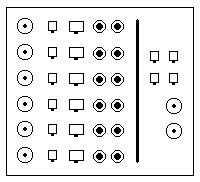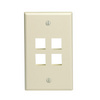For some it'll be easier than others. but this is a great way to post what and how you setup your houshold for video & LAN.
This idea came from posting in another thread and i figured people might want to know how people did their own setup for some ideas. And allow others to show off or help people setup their own home.
This is the Post I had started in another thread, to give you an idea.
https://forum.videohelp.com/viewtopic.php?p=1469139#1469139
------------------------------------------------------------------------------------
This is a panel I got from Home Depot. It's actually the little square modules that you pop into it. It's Coaxial, phone, CAT5e, 2xRCA on the left hand side. I have 5 rooms it's wired to. The right side is the input side with 4 phone jacks & 2 coaxial jacks for outside lines coming in.
What this allows me to do is wire which rooms how I want them to be wired. I can place the cable or DSL modem in my closet (DSL is what I currently have) along with a router to branch off for the lan. I have a 5x modular tree jack for the phones as all the phones are on the same line(so only 1 of the 4 input jacks is turned on currently), but I can have 8 lines (2 on each input jack) come in and send them off to any room I want. I can also turn on/off video signal to any room I choose.
My son has a tendency to play with knobs and destroy DVDs & VHS tapes. I keep the VCR/DVD player in my room closet, and all I need is a TV in his room. Each room has a modular outlet, similar to the one below, that uses the same modules that fit in my main panel.
I had to wallfish the wires along the existing cable line. Not a fun or easy job to do, but it worked. If you have the ability to rip out a wal, that is the best way to do it. I only did that with 2 rooms because we were doing some remodling changes. It wouldn't have been worth ripping out a wall just to install these lines otherwise.
+ Reply to Thread
Results 1 to 19 of 19
-

-
No but if you have a baseboard you can just remove that and remove some of the sheetrock or plater behinfd that.Originally Posted by Doramius
-
IF...you have a baseboard. The sanded stucco walls in this home go right to the floor. Though I normally wouldn't have a problem ripping out a wall and placing in a new sheet, its a pain in the a** to match stucco texture and look natural. Many people find its not a problem, however I've never done indoor wall stucco. I also hate stucco, PERIOD! If I rip out a little section, I'll rip out the whole thing and just make a smooth wall and put on some decorative paint or paper it.

-
You can always do it brute force like the cable installers. Get a huge drill and go through the walls or floors to the outside, basement or crawl space.
If you are doing any new construction, install conduit between floors and rooms. The future will be fiber (and a wireless alternative).Recommends: Kiva.org - Loans that change lives.
http://www.kiva.org/about -
it's actually not that hard & destructive to run, especially if you have an attic to run the cable/wire through.
your only limitation is that you have to run it semi-close to a power outlet.
pretty much you kill the power to the outlet you want to place it near, take the faceplate/connector off the power outlet, tie your wire/cable to the electricity cable, pull it up from the attic & drop the wire where you need to doing basically the same process.. except you'd tie a wire to the electricity cable as it's going up to get the wire from the attic.
-
That's really not a good method. That leaves the communication wires running too close and parallel to the AC and you could end up battling interference.Originally Posted by lumis"Shut up Wesley!" -- Captain Jean-Luc Picard
Buy My Books -
I agree. I'd avoid running communications wire any distance along an AC power line (including your doorbell). -had a small incident once because I had a phone line along a dorbell line once. Not cool when you have a 2 year old boy who discovered the doorbell and you're on the phone at the same time.
Though turning off the power to a line and pulling the cables through, while not using the outlet for power, is okay; you do lose that power outlet. Not really a good choice, either. If power is running down one space (or slat), then you usually want to move your communication lines down one space to either side.
Another helpful bit of advice is if you are running coaxial cable longer than 30-50 feet, you might want to invest in a signal booster. While it really doesn't matter where you put it, I prefer putting it 25-30 feet away from input-outlet. I have 1 spot that is a bit further away than all the others, so I put in a signal booster. It had a 120V plug on it, but I cut the plug off and ran the wire directly to a junction box in the attic.
CAT(5,5e,6) cable usually has a distance of like 300' ft. so I haven't had to worry about that much. I would suggest trying to clamp it down with coaxial hooks. Don't staple as they tend to cut or ruin the twisted pairs. make sure the line is a bit loose and has a tiny bit of play. Tight wires tend to kink bend or snap if too much tension happens to land on them.
If you run RCA lines like I did, make sure they are shielded. Even if you only use them for audio, you may change your mind in the future.
Something I invested in, but may be a little to extreme for others, is ferrite cores. I got a bulk supply of them online and ran them at the ends of the cables.
-
It would work for fiber but that is all about 2010.Originally Posted by gadgetguyRecommends: Kiva.org - Loans that change lives.
http://www.kiva.org/about -
i've never had issues with inteference.. but then again, all i've ever run that way is phone, cat5/6, & coaxial (analog/digital cable, directv, dishnetwork) cable. i'm not sure how RCA cables would be affected though.
but i imagine properly shielded cable would be able to work just fine.
-
I have been doing Cat 5 for a few years off and on as needed here and there, but I am kind of out in the cold on Cat 6&7. I mean I know that the specs are higher and all, but what devices really use them now?
I Have finally scrounged up enough parts and peices to do my place in Cat 5 (I can easily get Cat 6 cable, I think, and do the wiring with it, but the jacks are harder to come by I am sure) I could even do fiber Op (with the help of a tool owning buddy) But the hardware is out of my price range for sure, and it doesnt come to my door so why bother? Again what is the real benifit of anything over Cat 5 right now?
Just curiousIS IT SUPPOSED TO SMOKE LIKE THAT? -
In a normal home install there's really no advantage as the runs are relatively short and there's usually not alot of equipment interference.
"Shut up Wesley!" -- Captain Jean-Luc Picard
Buy My Books -
Cat 5e up for gigabit Ethernet.
Recommends: Kiva.org - Loans that change lives.
http://www.kiva.org/about -
Originally Posted by gadgetguy
I wasn't really worried about the sheilding (Although I always did wonder why Cat 5 wasn't sheilded from the get go, even with the twist) But what devices really use up all of the Cat 6 supposed speed capibilities? (And don't say video)IS IT SUPPOSED TO SMOKE LIKE THAT? -
hdmi to hdmi over cat5e uses all the bandwidth -- we have beet results with cat6 , and carry two HD signals over cat6 + communications (HDCP) 1080P ... can run it 200 feet that way ...
over 100 - 200 feet - we run fibre optic though ....
run lots of video nowdays on cat5e and cat6"Each problem that I solved became a rule which served afterwards to solve other problems." - Rene Descartes (1596-1650) -
Originally Posted by BJ_M
Hmmm, Me no tech savy. What you say'um?IS IT SUPPOSED TO SMOKE LIKE THAT? -
with cat5e and cat5 ... it is not just the cable that is an issue for 'best' bandwidth -- it is the terminations .. they have to be exactly the right length for the untwist and done just right ....
terminations and jacks are more an issue with faulty lan problems than cable is ..."Each problem that I solved became a rule which served afterwards to solve other problems." - Rene Descartes (1596-1650) -
Yep, I know some of that. Most of what I do know is from feild experience. Like, "put in a twist instead of taking one out to get orientated". And I have heard that the specs say a half inch of untwist is the max, but another guy told me that is only correct if it is a quarter inch per pair (tuff to do at the block)
What I was really getting at was, What eguipment or components actually push the envelope on Cat 6, but that's ok, I don't think I would know it if I saw it.IS IT SUPPOSED TO SMOKE LIKE THAT? -
well like the cisco 7000 series routers or any gigabyte stuff ....
now that i think about it -- time for me to get started in a major rewire at my place with fiber and cat6


 "Each problem that I solved became a rule which served afterwards to solve other problems." - Rene Descartes (1596-1650)
"Each problem that I solved became a rule which served afterwards to solve other problems." - Rene Descartes (1596-1650) -
Major databases and CAD work for PC applications, and video is starting to become a PC application. Video security and monitoring (babies, teenagers).
The jacks are stocked at most cabling warehouses, make sure they match your wallplates. Clips on the sides or top and bottom. Keep the untwist as short as possible, not hard once you get the hang of it. A good impact punchdown tool and RJ45 crimper is essential.
Two people, a fishtape, drill, long drillbit, drywall saw, and a nice long attic crawl are not too bad. If you are in the South, do this EARLY in the morning, unless you need to loose some wieght. Very hot in the attic, in Florida, in August.
Similar Threads
-
Wiring configuration for HTPC
By Haopengyou in forum Media Center PC / MediaCentersReplies: 1Last Post: 19th Apr 2011, 21:03 -
5 Pin DIN Plug - Wiring Diagram ??
By 12Quidkidinnit in forum AudioReplies: 7Last Post: 11th Sep 2010, 21:40 -
Dedicated Local Server for streaming Live Video on Lan and WiFi
By paul.hyd225 in forum Video Streaming DownloadingReplies: 0Last Post: 10th Sep 2010, 20:17 -
New NLE Coming: Video Lan Movie Creator
By ctlw83 in forum EditingReplies: 1Last Post: 25th Dec 2009, 10:44 -
LAN video conferencing software
By logicom in forum Video Streaming DownloadingReplies: 0Last Post: 27th Oct 2008, 21:57



![Computer details: Windows Server 2012 R2
(2x) 2.93 GHz Hex-Core Intel Xeon X5670
Toshiba OCZ RD400 NVMe PCI-Express 1TB card
(2x) onboard Crucial MX200 512GB SSD
60TB+ NAS storage [mixed amongst Synology 1515+ & 1815+]
144GB Registered DDR3
Plex Media Server Comp](/images/buttons/computer.gif)


 Quote
Quote